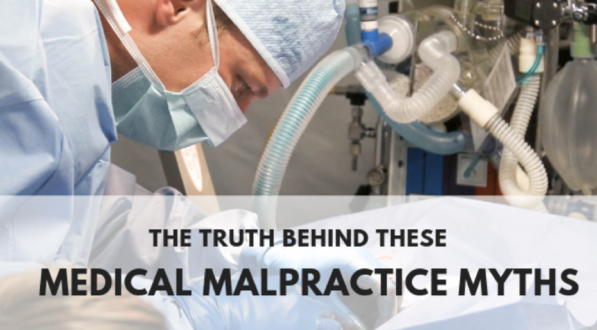The Truth Behind These 4 Medical Malpractice Myths
June 28, 2019

Medical errors happen every day. They occur in alarming numbers and are extremely costly. Some areas of inpatient and outpatient healthcare are particularly unsafe, such as pediatrics, surgery centers, emergency rooms, hospice care, intensive care units (ICUs), lower-volume hospitals, nursing homes/rehabilitation facilities, and more.
The average person may think because medical errors happen so frequently, that medical malpractice lawsuits are abundant and that these cases are clogging up the courts. But these are just two in a long list of medical malpractice myths that need to be cleared up.
Myth #1: “Fear of litigation” is the main reason doctors fail to report medical errors.
No. The main reason doctors and other health professionals fail to report medical errors is they don’t recognize certain instances are causing the patient harm. That’s right — they don’t realize certain events should be reported.
Maybe the person assumed someone else would report the episode. Or they thought it happened so frequently that it did not need to be reported. Some people even think because it’s unlikely to happen again, they don’t need to report it. Lack of understanding, education, and enforcement are the reasons for failing to report medical errors.
Myth #2: Medical malpractice cases are frivolous and common.
Despite the large number of medical errors occurring in healthcare facilities across the country, medical malpractice cases represent only 4 percent of state tort caseloads. Medical malpractice cases represent only 0.17 percent of state civil caseloads, and only approximately 1 in 5 patients harmed result in a lawsuit.
Other studies have estimated that as few as 2 to 3 percent of patients pursue litigation. This goes to show that the vast majority of medical errors causing patient harm never result in a lawsuit.
Myth #3: Medical malpractice payouts affect large numbers of doctors
Surprisingly (or not surprisingly), only a small number of doctors are responsible for most medical malpractice payouts. Incompetent physicians who cause medical errors are rarely held accountable by the federal government or state medical boards, leading to further medical errors and medical malpractice lawsuits. Instead of medical malpractice affecting a large number of physicians, it’s actually a small group of repeated offenders.
For example, one study found that 28 states have doctors who have been warned, yet have been allowed to practice unrestricted.
Myth #4: Medical malpractice cases are clogging the courts
Contrary to this belief among the general public, many medical malpractice cases are settled outside of court. According to averages calculated from the most recent NCSC data (2016), the percentage of medical malpractice cases resolved through jury trial in state courts is just
5.1 percent.
Other research shows that 90 percent of cases are settled without jury trial, with some estimates indicating that the figure is as high as 97 percent.
Customarily, if the insurance company and lawyers can conclude that the medical provider was negligent, the case is settled prior to reaching a jury. The threat of a jury trial is often what encourages parties to settle, since jury trials are costly and time-consuming.
Expert Witnesses for Medical Malpractice Lawsuits
No matter the type of medical malpractice case you are pursuing, you can trust Saponaro, Inc. for professional and objective expert witnesses. We’re here to help keep the process as streamlined as possible. We offer:
- RN review
- Medical experts
- Preliminary/Comprehensive Case Evaluations
- MD hotline
- Independent medical exams
You can find a consulting or testifying expert witness you need to strengthen your medical malpractice case. We have thousands of experts standing by to assist you. Find one today.
Source: “Medical Malpractice: By the Numbers”, Center for Justice & Democracy at New York Law School, December 2018 update.
